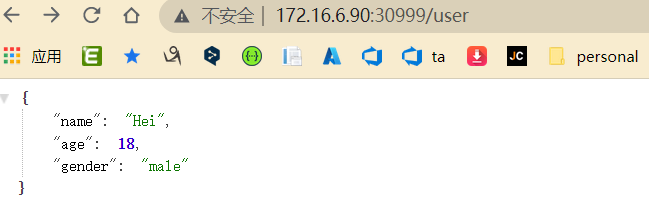k8s HPA(HorizontalPodAutoscaler)--自動水平伸縮

寫在前面
我們平時部署web服務,當服務壓力大撐不住的時候,我們會加機器(加錢);一般沒有上容器編排是手動加的,臨時加的機器,臨時部署的服務還要改Nginx的設定,最後回收機器的時候,也是手動回收,手動修改Nginx的,挺麻煩的其實;
而K8s是支援這整個流程的自動化的,也就是HPA;
HPA介紹
HPA:全稱Horizontal Pod Autoscaler ,對應中文叫Pod的自動水平伸縮;
Pod的水平伸縮是水平方向增加/減少Pod的數量;
Pod的垂直伸縮則是垂直方向上控制Pod的硬體,比如增加/縮減CPU、記憶體等資源;
k8s的HPA一般會根據一個具體的指標來做,比如常見CPU、記憶體的負載;也可以根據web服務的吞吐量、單位時間內的傳輸位元組數等;另外還可以根據自定義的指標,比如RabbitMQ的佇列數量、Webhook等;
我這裡先講講怎麼根據CPU、記憶體的負載來做HPA;
HPA實操
環境
$ kubectl version
Client Version: version.Info{Major:"1", Minor:"22", GitVersion:"v1.22.5"
Server Version: version.Info{Major:"1", Minor:"22", GitVersion:"v1.22.5"
$ kubectl get node
NAME STATUS ROLES AGE VERSION
docker-desktop Ready control-plane,master 177d v1.22.5
檢查獲取指標是否正常
是否安裝了metrics-server
HPA是需要獲取具體的指標做伸縮的, metrics-server是提供指標的
$ kubectl get pod -n kube-system|grep metrics-server
metrics-server-5d78c4b4f5-x5c46 1/1 Running 2 (3d12h ago) 10d
是否正常獲取指標
$ kubectl top node
docker-desktop 133m 0% 2671Mi 16%
如果沒有的,需先安裝metrics-server
安裝metrics-server
下載yaml
wget https://github.com/kubernetes-sigs/metrics-server/releases/latest/download/components.yaml
修改yaml
spec:
containers:
- args:
- --cert-dir=/tmp
- --secure-port=4443
- --kubelet-preferred-address-types=InternalIP,ExternalIP,Hostname
- --kubelet-use-node-status-port
- --metric-resolution=15s
- --kubelet-insecure-tls #加上這個(不推薦生產這樣用)
#image: k8s.gcr.io/metrics-server/metrics-server:v0.6.1 #這個映象需要梯子
image: registry.cn-hangzhou.aliyuncs.com/chenby/metrics-server:v0.6.1 #換成網友阿里雲的映象
imagePullPolicy: IfNotPresent
提交yaml
kubectl apply -f components.yaml -n kube-system
再驗證
kubectl get pod -n kube-system|grep metrics-server
kubectl top node
部署一個測試的Pod(Webapi)
建立一個hpa-api.yaml的檔案內容如下:
apiVersion: apps/v1
kind: Deployment
metadata:
name: hpa-api
spec:
selector:
matchLabels:
app: hpa-api
replicas: 1
template:
metadata:
labels:
app: hpa-api
spec:
containers:
- name: hpa-api
image: gebiwangshushu/hei-ocelot-api:1.0 #這是我寫其他文章上傳的映象,程式碼:https://github.com/gebiWangshushu/Hei.Ocelot.ApiGateway/blob/master/Hei.Api/Controllers/WeatherForecastController.cs
ports:
- containerPort: 80
resources:
requests:
cpu: 1000m
memory: 100Mi
# limits:
# cpu: 100m
# memory: 100Mi
---
apiVersion: v1
kind: Service
metadata:
name: hpa-api
labels:
app: hpa-api
spec:
ports:
- port: 80
nodePort: 30999
type: NodePort
selector:
app: hpa-api
kubectl apply -f hpa-api.yaml
這裡建立了一個測試的webapi,所用映象是gebiwangshushu/hei-ocelot-api:1.0,原始碼在這;這個Deployment的副本數是1,資源requests為cpu: 1000m memory: 100Mi;並且建立了一個nodePort:30999 型別的Service;
存取看看:

172.16.6.90 是我自己k8s叢集的地址;測試的webapi部署好了,我們來給他建立一個HPA(HorizontalPodAutoscaler);
建立HPA--HorizontalPodAutoscaler
檢視當前HPA支援版本:
$ kubectl api-versions|grep autoscaling
autoscaling/v1
autoscaling/v2beta1
autoscaling/v2beta2
autoscaling/v1: 只支援基於CPU的自動伸縮
autoscaling/v2beta1: 支援Resource Metrics(資源指標,如pod的CPU)和Custom Metrics(自定義指標)的縮放。
autoscaling/v2beta2:支援Resource Metrics(資源指標,如pod的CPU)和Custom Metrics(自定義指標)和ExternalMetrics(額外指標)的縮放。
建立一個HPA.yaml的檔案,內容如下:
apiVersion: autoscaling/v2beta2
kind: HorizontalPodAutoscaler
metadata:
name: hpa-api
spec:
scaleTargetRef:
apiVersion: apps/v1
kind: Deployment #針對Deployment做伸縮
name: hpa-api
minReplicas: 1 #最小副本數
maxReplicas: 10 #最大副本數
metrics:
- type: Resource
resource:
name: cpu
target:
type: Utilization #Utilization 使用率做指標
averageUtilization: 50 #CPU平均使用率超requests要求的cpu的50%時,開始做擴容
#type: averageValue
#averageValue: 30 #使用平均值averageValue(平均值) 做指標
-
type: Utilization #Utilization 表示用使用率作為指標,此外還有Value 或 AverageValue
-
averageUtilization: 50 表示CPU平均使用率超requests要求的cpu的50%時,開始做擴容
-
apiVersion: autoscaling/v2beta2 autoscaling的版本,不同版本的欄位和支援的指標不一樣;
當然,這裡的apiVersion: autoscaling/v2beta2 ,支援還支援很多引數,例如:
metrics:
- type: Resource
resource:
name: cpu
target:
type: Utilization
averageUtilization: 60 #CPU平均負載超requests60%時,開始做擴容
# - type: Resource
# resource:
# name: cpu
# target:
# type: AverageValue
# averageValue: 500m
# - type: Pods #Pods型別的指標
# pods:
# metric:
# name: packets-per-second
# target:
# type: AverageValue
# averageValue: 1k
# - type: Object
# object:
# metric:
# name: requests-per-second
# describedObject:
# apiVersion: networking.k8s.io/v1
# kind: Ingress
# name: main-route
# target:
# type: Value
# value: 10k
# behavior: #控制伸縮行為速率的
# scaleDown:
# policies: #支援多個策略
# - type: Pods
# value: 4
# periodSeconds: 60 #60秒內#最多縮容4個pod
# - type: Percent
# value: 300
# periodSeconds: 60 #60秒內#最多縮容300%
# selectPolicy: Min
# stabilizationWindowSeconds: 300
# scaleUp:
# policies:
# - type: Pods
# value: 5
# periodSeconds: 60 #60秒內#最多縮容5個pod
# # - type: Percent
# # value: 100 #最多擴容100%
# # periodSeconds: 60 #60秒內
# selectPolicy: Max
# stabilizationWindowSeconds: 0
metrics中的type欄位有四種型別的值:Object、Pods、Resource、External。
- Resource:指的是當前伸縮物件下的pod的cpu和memory指標,只支援Utilization和AverageValue型別的目標值。
- Object:指的是指定k8s內部物件的指標,資料需要第三方adapter提供,只支援Value和AverageValue型別的目標值。
- Pods:指的是伸縮物件(statefulSet、replicaController、replicaSet)底下的Pods的指標,資料需要第三方的adapter提供,並且只允許AverageValue型別的目標值。
- External:指的是k8s外部的指標(比如prometheus),資料同樣需要第三方的adapter提供,只支援Value和AverageValue型別的目標值。
另外還有自定義指標等,需要1.23及以上版本才支援了;
建立HPA資源
kubectl apply -f HPA.yaml
檢視HPA
$ kubectl get hpa
NAMESPACE NAME REFERENCE TARGETS MINPODS MAXPODS REPLICAS AGE
aspnetcore hpa-api Deployment/hpa-api 0%/50% 1 10 1 8d
驗證
hpa開啟watch監控模式
$ kubectl get hpa --watch
NAME REFERENCE TARGETS MINPODS MAXPODS REPLICAS AGE
hpa-api Deployment/hpa-api 0%/50% 1 10 1 8d
...
#阻塞監聽狀態
用ab壓測工具壓一下
ab -n 200000 -c 10 http://172.16.6.90:30999/user
沒安裝的自己搜尋安裝下,這裡的 -n:請求個數,-c : 請求並行數
檢視資源使用情況
$ kubectl top po
NAME CPU(cores) MEMORY(bytes)
hpa-api-88ddc5c49-2vgjd 1m 301Mi
hpa-api-88ddc5c49-4h5pz 1m 300Mi
hpa-api-88ddc5c49-8c8d2 1m 340Mi
hpa-api-88ddc5c49-8hmnm 1m 300Mi
hpa-api-88ddc5c49-cgxm9 1m 23Mi
hpa-api-88ddc5c49-tdrc6 1m 23Mi
擴容情況
kubectl get hpa --watch
NAME REFERENCE TARGETS MINPODS MAXPODS REPLICAS AGE
hpa-api Deployment/hpa-api 0%/50% 1 10 1 8d
hpa-api Deployment/hpa-api 262%/50% 1 10 1 8d
hpa-api Deployment/hpa-api 33%/50% 1 10 4 8d
hpa-api Deployment/hpa-api 0%/50% 1 10 6 8d #這裡請求結束了
伸容過程
$ kubectl describe hpa hpa-api
Name: hpa-api
...
Reference: Deployment/hpa-api
Metrics: ( current / target )
resource cpu on pods (as a percentage of request): 262% (2628m) / 50% #這裡資源直接遠超1000m的50%,達到了262% (2628m)
Deployment pods: 1 current / 4 desired
..
Deployment pods: 1 current / 4 desired
Conditions:
Type Status Reason Message
---- ------ ------ -------
AbleToScale True SucceededRescale the HPA controller was able to update the target scale to 4
ScalingActive True ValidMetricFound the HPA was able to successfully calculate a replica count from cpu resource utilization (percentage of request)
ScalingLimited True ScaleUpLimit the desired replica count is increasing faster than the maximum scale rateEvents:
Type Reason Age From Message
---- ------ ---- ---- -------
Normal SuccessfulRescale 39s horizontal-pod-autoscaler New size: 4; reason: cpu resource utilization (percentage of request) above target #擴容到4個
Normal SuccessfulRescale 3m11s horizontal-pod-autoscaler New size: 6; reason: All metrics below target #擴容到6個
一旦 CPU 利用率降至 0,HPA 會自動將副本數縮減為 1;
擴容詳情
HPA 控制器基於 Master 的 kube-controller-manager 服務啟動引數 --horizontal-pod-autoscaler-sync-period 定義的探測週期(預設值為 15s) , 週期性地監測目標 Pod 的資源效能指標, 並與 HPA 資源物件中的擴縮容條件進行對比, 在滿足條件時對 Pod 副本數量進行調整。
在每個時間段內,控制器管理器都會根據每個 HorizontalPodAutoscaler 定義中指定的指標查詢資源利用率。 控制器管理器找到由 scaleTargetRef 定義的目標資源,然後根據目標資源的 .spec.selector 標籤選擇 Pod, 並從資源指標 API(針對每個 Pod 的資源指標)或自定義指標獲取指標 API(適用於所有其他指標)。
-
對於按 Pod 統計的資源指標(如 CPU),控制器從資源指標 API 中獲取每一個 HorizontalPodAutoscaler 指定的 Pod 的度量值,如果設定了目標使用率, 控制器獲取每個 Pod 中的容器資源使用 情況, 並計算資源使用率。如果設定了 target 值,將直接使用原始資料(不再計算百分比)。 接下來,控制器根據平均的資源使用率或原始值計算出擴縮的比例,進而計算出目標副本數。
需要注意的是,如果 Pod 某些容器不支援資源採集,那麼控制器將不會使用該 Pod 的 CPU 使用率。
-
如果 Pod 使用自定義指示,控制器機制與資源指標類似,區別在於自定義指標只使用 原始值,而不是使用率。
-
如果 Pod 使用物件指標和外部指標(每個指標描述一個物件資訊)。 這個指標將直接根據目標設定值相比較,並生成一個上面提到的擴縮比例。 在
autoscaling/v2beta2版本 API 中,這個指標也可以根據 Pod 數量平分後再計算。
HorizontalPodAutoscaler 的常見用途是將其設定為從(metrics.k8s.io、custom.metrics.k8s.io 或 external.metrics.k8s.io)獲取指標。 metrics.k8s.io API 就是我們前面安裝Metrics Server 的外掛;
擴容演演算法
期望副本數 = ceil[當前副本數 * (當前指標 / 期望指標)]
例如,如果當前指標值為
200m,而期望值為100m,則副本數將加倍, 因為200.0 / 100.0 == 2.0如果當前值為50m,則副本數將減半, 因為50.0 / 100.0 == 0.5。如果比率足夠接近 1.0(在全域性可設定的容差範圍內,預設為 0.1), 則控制平面會跳過擴縮操作。
套入上面的範例:
期望副本數 = ceil[ 1 * (262% / 50%)] == 6
類似本範例的示意圖:

可以看到這裡的指標,是針對所有pod的;
總結
k8s的東西太多,只學了點皮毛,有個基本的概念就趕緊記下來;k8s叢集版本、HPA的版本的不同又有很多限制與欄位的區別,需要後面更多的實踐與學習;
[參考]
https://kubernetes.io/zh-cn/docs/tasks/run-application/horizontal-pod-autoscale/
https://blog.51cto.com/smbands/4903843
https://www.cnblogs.com/fanggege/p/12299923.html